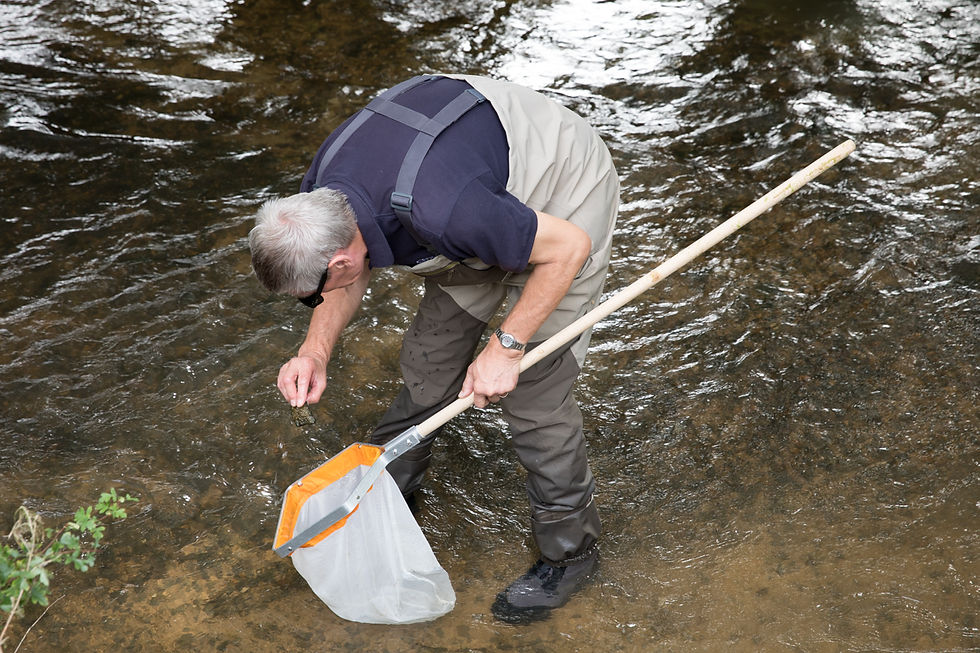Looking for pollution's footprint
- Ashley Smith
- Sep 15, 2018
- 3 min read
What is a riverfly survey?

Last week we went out on the Windrush with Tony Bostock from the Severn Rivers Trust to conduct riverfly surveys.
Why not just take water samples? Well, it depends when you take them. The water in front of you in a river will be moving and may be clean one minute and carrying pollution the next. We know that is what happens, in addition to the entry of a constant stream of sewage effluent that varies in quantity and quality at different times of day.
Take a sample and you take your chances on what you get. It could be clean and a minute later it could be toxic. The insects that live in it will tell you more about that because they may have been wiped out or their numbers suppressed or reduced.
Many insects lay their eggs in water and some, like shrimps, live there for their entire lives. The eggs produce larvae which live in the water for a year or more, generally. Think, for example, of the Mayfly that emerge from our waters around May and June to become flying insects, mate within a couple of days or so, lay their eggs in the water and die. Many are eaten by fish and birds and provide a great bonus to the food chain when they emerge from the water at an important time of the year.
Had a nice day! Here is a Mayfly. Work done, eggs laid and a day or so of winged life is over. Lets hope those eggs hatched and enough larvae can survive the year in the water.

A whole host of other creatures do similar things including dragonflies, which seem to be very scarce around the Windrush these days.
The invertebrate sampling is done in similar habitats on the river where the sampler can wade in and kick up the gravel or stones to dislodge the insect life which is pushed downstream by the current and into a net. The same sized nets are used by the samplers, including the Environment Agency, and the same methods of kicking for a total of three minutes are used. Consistency is the key.
The samples are then viewed and counted in trays to identify species and count or estimate numbers.

Making sense of it.
Various numbers or bands of numbers of pollution sensitive species are allocated a score and the totals give a figure for the quality of the river at that point.

Some of you will know cased caddis grubs as the larvae that build a protective case around their bodies from very small pieces of wood or gravel. A real work of art. The photo below shows some empty cases but no fresh and occupied ones. We want to know more about why that is.
We did find healthy looking cased and caseless caddis in the upper river but only one caseless caddis at Burford and none at Newbridge downstream of Witney.
These are creatures that many of you who spent time in and around the river will remember attached to virtually every stick or stone you picked out of the river. Not any more and that should worry us all.

The final results for the four sites we sampled showed poor results for the river at and below Burford and good results up at Naunton upstream of Bourton on the Water.
Wriggling with life. This nice looking catch below came from the upper river.

Windrush Against Sewage Pollution is arranging training for some volunteers so that we can make a comprehensive survey of the river which we will share with the Environment Agency and also offer to Thames Water.

This is going to be fascinating and enlightening, from what we have seen on our first forays with Tony. We have seen similar interesting differences whilst out with the scientists from the Centre for Ecology and Hydrology doing the freshwater shrimp work you may have seen in an earlier blog.
If you would like to be a WASP Riverfly Monitor, please contact us via the website. There will be a charge attached to the training and purchase of the equipment which will depend on numbers which we can tell you more about. Maybe the angling clubs or wild swimmers will be interested as you guys are used to being in and around the river.


Comments